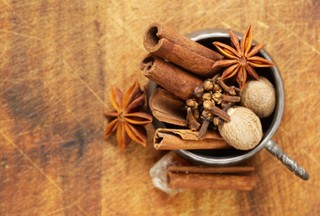The best winter herbs and spices for every occasion

Everyone knows that the onset of cooler temperatures is marked not by the changing colors of leaves on the trees, but by the emergence of pumpkin spice lattes. And of course, look no further than the stuffing on the Thanksgiving table to see the classic winter herbs in action: parsley, sage, rosemary, and thyme. In honor of the holiday season, we’ve cooked up a guide the best winter herbs and spices for you to enjoy in the cold weather.
What is the difference between herbs and spices?
The main difference between herbs and spices centers on what part of a plant they are harvested from.
Herbs
The word “herb” refers to the leaves on a plant: such as cilantro, tarragon, chives, and the many other aromatic plants typically found growing in an herb garden.
Spices
Spices are derived from non-leafy parts of a plant: the bark, bulb, roots, seeds, and stems. The same plant sometimes can produce both herb and spice: cilantro seeds are known in the culinary world as coriander. Most spices come from tropical parts of the world, which is why they were once precious.

The best winter herbs
Winter herbs can be a little tricky, as most climates prohibit year-round outdoor harvesting of all but the hardiest of fresh herbs. Fortunately, most perennial herbs grow well indoors on a windowsill, and these five superstars are no exception. The fussiest foodie will be grateful to have indoor herbs through the coldest months.
Oregano
Despite the Mediterranean origins of this savory herb, oregano is incredibly hardy and can handle a bit of frost without complaint. Marjoram, the sweetest variant of oregano, is also the most delicate and can’t take the cold. Nevertheless, both love being grown indoors in pots and will produce happily all year round.
Use oregano to compliment any Italian dish, but it also pairs well with almost any meat or fish and adds a certain charm to ordinary recipes like grilled cheese sandwiches, potato salads, and so much more.
Parsley
With a reputation for adding a splash of brightness to rocky mountain sides and mouth watering recipes, parsley is likely to thrive on a sunny windowsill. As winter drags on, sometimes a burst of flavor and freshness is all you need to perk right up. Parley pairs well with roasted root vegetables, winter squashes, and soups. Chopped finely, it adds dimension to any savory dish sprinkled liberally on top before serving.
Rosemary
Another Mediterranean herb, rosemary stands strong through winter if protected adequately.
This pungent herb is a natural fit for smoky, grilled flavors and is well suited to chicken or eggplant stews. The strong flavor is a traditional feature of focaccia bread, and it performs well in baking. Add to meat dishes (lamb in particular), potatoes, and just about any winter vegetables.

The enthusiast's guide to herbs
We’re proud to present our new e-book, The Enthusiast’s Guide to Herbs! Learn everything you need to know about growing and caring for herbs indoors, including in-depth info cards for the 35 most commonly grown herbs.
Click the link below to find out more!
Sage
With its soft, silvery-blue leaves, sage is a lovely ornamental plant that looks stunning on any windowsill. Its distinctive flavor makes it a perfect addition to pork, beef, or duck–fatty meats generally benefit from it the most. But in Italian cooking, chopped fresh sage is often combined with melted butter and used to top pasta or spread on bread.
Thyme, oregano, and rosemary.
Thyme
Woody-stemmed thyme is hardy indoors or out and is one of the most versatile herbs in the garden. Like other Mediterranean herbs, it prefers It pairs perfectly with tomatoes, but also complements lamb, fish, sauces, and soups. Blended with oil and vinegar it makes a lovely marinade and the leaves add a zesty boost to salads and cooked vegetables.
Winter Savory
True to name, winter savory is a hardy perennial that withstands the ravages of winter in many climates. It has a clean, peppery and piney flavor and dense, evergreen leaves. Perhaps the fact that it endures winter is why savory is a staple in so many traditional cold-weather recipes. The chopped leaves are perfect in stuffing, bean dishes, soups, and stews.
The best winter spices
When we think of winter spices, we tend to imagine rich, pungent desserts and drinks. For the most part, winter spices come from the tropics, bringing with them warm, comforting flavor profiles.
Cloves
Native to Indonesia, cloves are the aromatic flower buds harvested from the Syzygium aromaticum tree. Used traditionally as a painkiller for tooth and oral pain. However, the topical uses for cloves are still being explored for the powerful antioxidant properties of the spice. (3)
Yet another component in pumpkin pie spice and chai, the flavor of cloves is so intense that they are used sparingly in cooking and baking. Cloves lend a unique flavor to meats and stews, and factor in heavily in Mexican mole. Mulled wines and ciders always include cloves, and it plays a small role in eggnog. It is not uncommon to see cloves studding a holiday ham or encrusting an orange as an aromatic decorative holiday element.
Cinnamon
Harvested from the inner bark of Cinnamomum trees, this spice has been with humans for centuries, with records of its import to Egypt dating back to 2000 BC. Virtually all of the world’s cinnamon comes from Indonesia, China, Vietnam, and Sri Lanka. Cinnamon has long been used as a digestive aid in traditional medicine, and some clinical studies have shown it to have anti-inflammatory properties. (2)
Mostly, we know cinnamon as a key ingredient of cinnamon rolls, pumpkin spice mix, and pie spices. But the slightly sweet, distinctive spice makes an appearance in many savory dishes as well. From winter squash soups to roasted veggie hash to rice pilafs and Moroccan tagines, cinnamon plays well with many savory dishes.
Nutmeg
Indigenous to Southeast Asia, nutmeg is the seed of the Myristica fragrant tree. The coating of the seed is harvested and dried to make mace, another potent spice. The tree it grows from doesn’t produce seeds until it is seven to nine years old and won’t reach full capacity until it is twenty years old.
Nutmeg is a key ingredient in béchamel sauce, eggnog, mulled wine and is used in spice mixes such as pumpkin pie spice. A tiny dash of nutmeg in quiches, roasted cauliflower, and winter squash soups lends a delicate bit of sweetness.
Ginger
Spicy, warming and pungent, ginger is a root that grows in tropical climates. Prized as a cure for nausea and upset stomach, it has also been researched for its ability to relieve the pain in patients with osteoarthritis. (1)
Ginger is a traditional flavoring element in many Asian dishes. It can be used as a rub in meat dishes and contains an enzyme that helps to tenderize meat when used as a marinade. Ginger can be sliced and added to stir-fries, curries, or stews to add its distinctive warmth. Powdered ginger is an unmistakable element in chai tea, gingerbread, and pumpkin pie spice, but bakers often add ginger to desserts to give them a bit of a kick.
Cardamom
Originating in Southeast Asia but now grown commercially in Guatemala, cardamom is the third-most-expensive spice on earth, behind vanilla and saffron. This is because harvesting cardamom pods is meticulous, labor-intensive work that must be done by hand. The flavor of cardamom is sweet, smokey, and menthol-like. In the Middle East, ground cardamom is combined with coffee to produce a pungent brew.
A primary part of the flavor profile of chai tea and Indian rice pudding, cardamom is also used in savory dishes and baking. Cardamom adds an unexpected twist to chicken, inspired salads, tikka masala, and spiced rice recipes. Inventive chefs have paired it with tangy tomato sauces and delicate poached pears to great effect.
Conclusion
In these cold winter months, your culinary life will be enriched by keeping an indoor herb garden and a well-stocked spice rack. Even though it may be cold outside, these herbs and spices will help keep you feeling warm and nourished.

Join our email club—get printable info cards free!
Sign up to receive our newsletter and get access to 10 printable plant info cards from our e-book for free. Also receive:
- $4 discount code for our Guide to Herbs e-book
- Semi-weekly plant inspiration & bite-size tips and tricks


